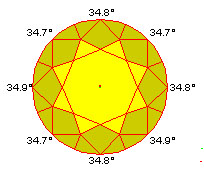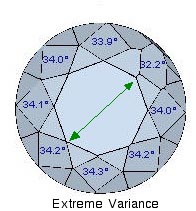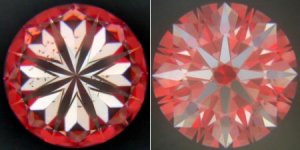You are using an out of date browser. It may not display this or other websites correctly.
You should upgrade or use an alternative browser.
You should upgrade or use an alternative browser.
how important is consistency in crown/pavillion angles?
- Thread starter g2man
- Start date
- Status
- Not open for further replies. Please create a new topic or request for this thread to be opened.
JohnQuixote
Ideal_Rock
- Joined
- Sep 9, 2004
- Messages
- 5,212
- Joined
- Aug 15, 2000
- Messages
- 18,502
In other words - the #''s can be way off - more than 1 degree, and thw symmetry can be fantasic - or the #''s can be 1/4 degree off and the stone is a mess.
An optical viewer like a H&A''s or ideal-scope is of more value than a Sarin scan.
An optical viewer like a H&A''s or ideal-scope is of more value than a Sarin scan.
strmrdr
Super_Ideal_Rock
- Joined
- Nov 1, 2003
- Messages
- 23,295
Date: 11/25/2004 1:22:12 AM
Author:g2man
If you have a diamond with ideal average crown/pavillion angles, but there is a large disparity in min/max angles, is that bad? Let''s say the average crown angle is 34.5 which is good, but the mininum is 34 and the maximum 35, is that bad?
With very few exceptions exceptions id pass if there was an ideal cut price tag attached to it.
I like to see much tighter measurements if im paying a premium for the stone.
strmrdr
Super_Ideal_Rock
- Joined
- Nov 1, 2003
- Messages
- 23,295
For example and since John posted in this thread I will use WF for an example.
In an aca price class diamond Id find it unacceptable but in a WF expert selection price class diamond if everything else checks out it would be more acceptable to me.
In an aca price class diamond Id find it unacceptable but in a WF expert selection price class diamond if everything else checks out it would be more acceptable to me.
orbaya
Brilliant_Rock
- Joined
- Nov 2, 2004
- Messages
- 1,627
I guess I''m confused on the question the OP asked. To me, it looks like the number, 34.5 and that is in the middle of the mininum and maximum, how is that bad? It falls with within the range doesn''t it? Or am I just being a moron?

Isn''t it like saying that the table %''s are 53-58% and a particular diamond''s is a 55...so that falls within that range?

Isn''t it like saying that the table %''s are 53-58% and a particular diamond''s is a 55...so that falls within that range?
JohnQuixote
Ideal_Rock
- Joined
- Sep 9, 2004
- Messages
- 5,212
Date: 11/25/2004 7:500 AM
Author: orbaya
I guess I'm confused on the question the OP asked. To me, it looks like the number, 34.5 and that is in the middle of the mininum and maximum, how is that bad? It falls with within the range doesn't it? Or am I just being a moron?
Isn't it like saying that the table %'s are 53-58% and a particular diamond's is a 55...so that falls within that range?
Hi Orbaya (happy Holidays)

The overall number given for crown angle (34.8 for example) is an average of 8 measurements. To determine how precise the physical symmetry is (again stressing that physical symmetry is different than lab-graded symmetry), we can look at this graphic on the sarin report, below. Since this diamond has a minimum of 34.7 and a max of 34.9 we already know it's likely to be tight.
Here is the example: Overall, 34.8 crown angle (see how the opposite angles all average near 34.8?) and small variance. This is a very tight crown.

JohnQuixote
Ideal_Rock
- Joined
- Sep 9, 2004
- Messages
- 5,212
Continuing with another crown example, here is a diamond with what I would consider "extreme variance."
The crown angle is given as 33.9 degrees (average of 8 measurements). However, the minimum is 32.2 and the maximum is 34.3. That's 2.1 degrees overall variance. Moreover, the illustrated set of opposite angles varies by 2 degrees on its own. The other 3 sets of opposites average closer to 34.1, but because of the one extreme the overall crown angle becomes 33.9.

The crown angle is given as 33.9 degrees (average of 8 measurements). However, the minimum is 32.2 and the maximum is 34.3. That's 2.1 degrees overall variance. Moreover, the illustrated set of opposite angles varies by 2 degrees on its own. The other 3 sets of opposites average closer to 34.1, but because of the one extreme the overall crown angle becomes 33.9.

JohnQuixote
Ideal_Rock
- Joined
- Sep 9, 2004
- Messages
- 5,212
Date: 11/25/2004 5:46:30 AM
Author: Garry H (Cut Nut)
In other words - the #'s can be way off - more than 1 degree, and thw symmetry can be fantasic - or the #'s can be 1/4 degree off and the stone is a mess.
An optical viewer like a H&A's or ideal-scope is of more value than a Sarin scan.
Garry is "Spot-on."
Even with notable variance a diamond can display decent optical symmetry (the result of physical symmetry) so long as those opposites average.
Here are the H&A images of the diamond above with extreme variance. Even with extreme variance in crown angles the patterning is not what I would call poor. This diamond does not display "True" H&A, but there are much worse examples out there.

JohnQuixote
Ideal_Rock
- Joined
- Sep 9, 2004
- Messages
- 5,212
Date: 11/25/2004 6:50:39 AM
Author: strmrdr
For example and since John posted in this thread I will use WF for an example.
In an aca price class diamond Id find it unacceptable but in a WF expert selection price class diamond if everything else checks out it would be more acceptable to me.
And, Strm, for the most part you would be right with regard to the way those lines are treated. However, if you are looking for optical symmetry, the H&A and IS images should take priority over the nitpicky numbers: As you can see, above (not a WF stone, by the way), the fact that the angles get near an average (on the whole) causes the optics to be better than one might have expected. Not "True" by your standards, maybe, but that diamond will be pretty. If you are not looking for optical symmetry, the IS never lies.
To the OP: ...And since this thread was not initially about optical symmetry, it bears mention that stones which are not cut to be H&A can be as beautiful as those which are cut purposely for optical symmetry, extreme variance or no. The eyes are always going to have the final say.
Moreover (and this applies to both H&A and non-H&A diamonds) Brian has noted that a range of variation in opposite angles can improve overall scintillation and contrast

strmrdr
Super_Ideal_Rock
- Joined
- Nov 1, 2003
- Messages
- 23,295
Just to clarify.
You can have 3 very good looking diamonds.
1 One super-ideal h&a
2 One ideal h&a to near h&a
3 One non-ideal non-h&a
All of them might look great, different from one another but still look great.
The point is that they will be different prices.
A wide variation in angles in my opinion moves it down to the #2 spot.
Thats ok as long as the price reflects this and it looks beautiful to you and all the other info looks good.
You can have 3 very good looking diamonds.
1 One super-ideal h&a
2 One ideal h&a to near h&a
3 One non-ideal non-h&a
All of them might look great, different from one another but still look great.
The point is that they will be different prices.
A wide variation in angles in my opinion moves it down to the #2 spot.
Thats ok as long as the price reflects this and it looks beautiful to you and all the other info looks good.
g2man
Rough_Rock
- Joined
- Jul 29, 2004
- Messages
- 25
Would a 1 degree variance between min/max crown angles be considered too severe in an AGS triipe 0 ideal?
I put the measurements for this diamond in the HCA and it comes up with .4 using the averages. If I use the extreme angles, I get HCA scores between .3 and 2.3. I don't know if the extreme HCA scores are possible since the position of the related crown/pavillion angles would have to be known and I have no way of knowing where they are.
Should I be more comfortable with a diamond that has a HCA score of .9 using the averages and say .7 and 1.7 using the extremes?
I put the measurements for this diamond in the HCA and it comes up with .4 using the averages. If I use the extreme angles, I get HCA scores between .3 and 2.3. I don't know if the extreme HCA scores are possible since the position of the related crown/pavillion angles would have to be known and I have no way of knowing where they are.
Should I be more comfortable with a diamond that has a HCA score of .9 using the averages and say .7 and 1.7 using the extremes?
strmrdr
Super_Ideal_Rock
- Joined
- Nov 1, 2003
- Messages
- 23,295
Date: 11/25/2004 1:393 PM
Author: g2man
Should I be more comfortable with a diamond that has a HCA score of .9 using the averages and say .7 and 1.7 using the extremes?
I would be but it depends on the price and how the rest of it looks.
The hca isnt the final answer its just one piece of the puzzle.
JohnQuixote
Ideal_Rock
- Joined
- Sep 9, 2004
- Messages
- 5,212
Date: 11/25/2004 1:393 PM
Author: g2man
Would a 1 degree variance between min/max crown angles be considered too severe in an AGS triipe 0 ideal?
I put the measurements for this diamond in the HCA and it comes up with .4 using the averages. If I use the extreme angles, I get HCA scores between .3 and 2.3. I don't know if the extreme HCA scores are possible since the position of the related crown/pavillion angles would have to be known and I have no way of knowing where they are.
Should I be more comfortable with a diamond that has a HCA score of .9 using the averages and say .7 and 1.7 using the extremes?
Garry can check my "math" here...I am not the master of HCA, just a pundit.
HCA is accurate using overall crown & pavilion angles (logical averaging), but using the extremes in that manner is not going to be meaningful. Remember that these angles don't work independently of each other. One set of opposites will not strike your eye as a .3 while another strikes it as a 2.3 and a third strikes it as something else

Also worthy of note is that .4, .9 and 1.7 may be equally beautiful in your eyes. I think that with the 1 degree variance and several excellent HCA indications it is safe to say you are seriously splitting hairs (but we love that here!).
- Joined
- Aug 15, 2000
- Messages
- 18,502
You guys have raised some interesting issues.
1. HCA is for rejection - if the score is good - ask for an ideal-scope image etc - if it is bad - dont waste the dealers time.
2. if you have an IS image - dont waste anyones time.
3. if you want a H&A''s - then an IS is good too.
4. H&A''s and HCA work well - but you can still get a cheated girdle that will not look great.
You can read more here http://www.gemology.ru/cut/english/symmetry/6.htm for a thorough understanding
1. HCA is for rejection - if the score is good - ask for an ideal-scope image etc - if it is bad - dont waste the dealers time.
2. if you have an IS image - dont waste anyones time.
3. if you want a H&A''s - then an IS is good too.
4. H&A''s and HCA work well - but you can still get a cheated girdle that will not look great.
You can read more here http://www.gemology.ru/cut/english/symmetry/6.htm for a thorough understanding
orbaya
Brilliant_Rock
- Joined
- Nov 2, 2004
- Messages
- 1,627
John,
Thanks for explaining about crown angle averages and the diagrams...very appreciated! It''s amazing that 1 degree can make or break a diamond so to speak. But with small objects such as diamonds I can see where 1 degree could make a big difference. I never imagined there was so much to know about these beauties!

Thanks for explaining about crown angle averages and the diagrams...very appreciated! It''s amazing that 1 degree can make or break a diamond so to speak. But with small objects such as diamonds I can see where 1 degree could make a big difference. I never imagined there was so much to know about these beauties!

JohnQuixote
Ideal_Rock
- Joined
- Sep 9, 2004
- Messages
- 5,212
Date: 11/25/2004 10:44:29 PM
Author: orbaya
John,
Thanks for explaining about crown angle averages and the diagrams...very appreciated! It''s amazing that 1 degree can make or break a diamond so to speak. But with small objects such as diamonds I can see where 1 degree could make a big difference. I never imagined there was so much to know about these beauties!
You''re quite welcome. There is much to this...and more to come.
I do want to be sure you understood the important point that a stone can have such variance (1 degree or even more perhaps) and still have spotless optical symmetry as long as the opposite slope angles average correctly. Also, as mentioned, even if the angles vary by only 1/4 a degree (or smaller) the stone could be a mess - this gets us into facet yaw. Actually, so does the example of tilted table that Garry mentioned, so - as promised - more on this in a bit.
JohnQuixote
Ideal_Rock
- Joined
- Sep 9, 2004
- Messages
- 5,212
Brian Gavin (your friendly neighborhood cutter) just called to say Happy TG and offered a couple of further thoughts for the gemophiles:
*The pavilion angles really are the #1 concern. After that the crown, which is reactionary to the pavilion.
*The variance in pavilion should match up to crown variance (indexing). This makes the center of the culet and the table key.
*Variation is fine so long as the 4 sets of opposites average correctly (we've said this but it's important)

He also asked me to discuss yaw, which is topical here, especially relating to the link Garry provided (forthcoming).
*The pavilion angles really are the #1 concern. After that the crown, which is reactionary to the pavilion.
*The variance in pavilion should match up to crown variance (indexing). This makes the center of the culet and the table key.
*Variation is fine so long as the 4 sets of opposites average correctly (we've said this but it's important)

He also asked me to discuss yaw, which is topical here, especially relating to the link Garry provided (forthcoming).
re:the minimum is 32.2, Moreover, the illustrated set of opposite angles varies by 2 degrees on its own. Date: 11/25/2004 10:467 AM
Author: JohnQuixote
Continuing with another crown example, here is a diamond with what I would consider ''extreme variance.''
The crown angle is given as 33.9 degrees (average of 8 measurements). However, the minimum is 32.2 and the maximum is 34.3. That''s 2.1 degrees overall variance. Moreover, the illustrated set of opposite angles varies by 2 degrees on its own. The other 3 sets of opposites average closer to 34.1, but because of the one extreme the overall crown angle becomes 33.9.
The real reason of such bad result should be the wrong scann. See 3d model.
JohnQuixote
Ideal_Rock
- Joined
- Sep 9, 2004
- Messages
- 5,212
Date: 11/26/2004 1:36:12 AM
Author: Serg
The real reason of such bad result should be the wrong scann. See 3d model.
Certainly a possibility. I appreciate the suggestion... I am on a macintosh right now and can't run the program (will do tomorrow).
Thanks, Serg.
JohnQuixote
Ideal_Rock
- Joined
- Sep 9, 2004
- Messages
- 5,212
Well guys, Garry’s tilted table link brings up a condition Brian Gavin has been pointing out for some time now: Facet yaw. The prior statement regarding angle variance: “the #''s can be 1/4 degree off and the stone is a mess” is wholly accurate and can also be explained by yaw in many instances.
Though it is pertinent to this thread, it is broad enough to be it’s own topic. For any interested, I worked on points for discussion and posted it here...Facet Yaw.
Hope to see you there

Though it is pertinent to this thread, it is broad enough to be it’s own topic. For any interested, I worked on points for discussion and posted it here...Facet Yaw.
Hope to see you there

- Status
- Not open for further replies. Please create a new topic or request for this thread to be opened.
Celebrating Mothers And Mentors This Mother's Day
Celebrating Mothers And Mentors This Mother's Day - 05/05
Did You Miss the April 2024 Jewels of the Weeks?
Did You Miss the April 2024 Jewels of the Weeks? - 04/26




300x240.png)